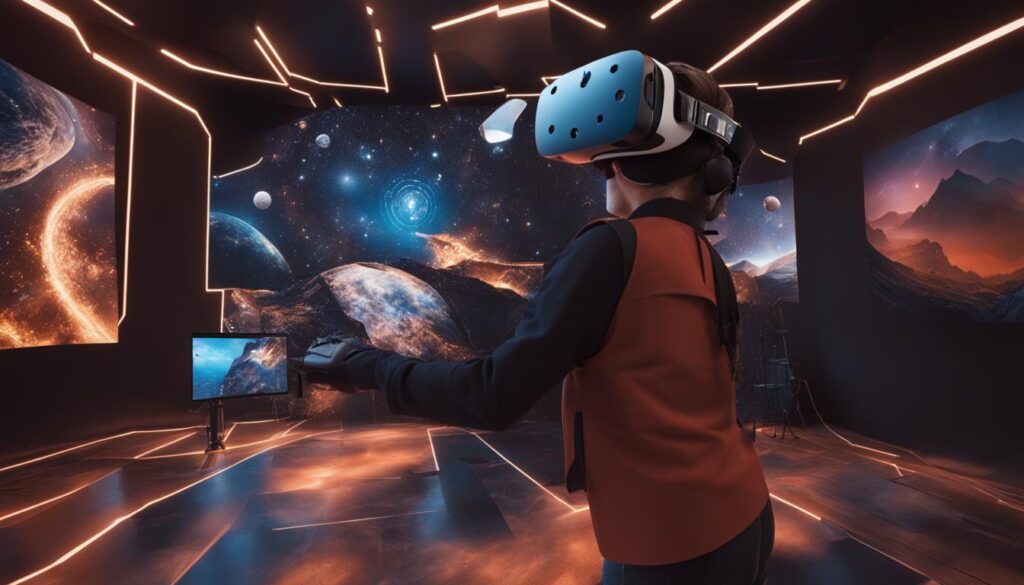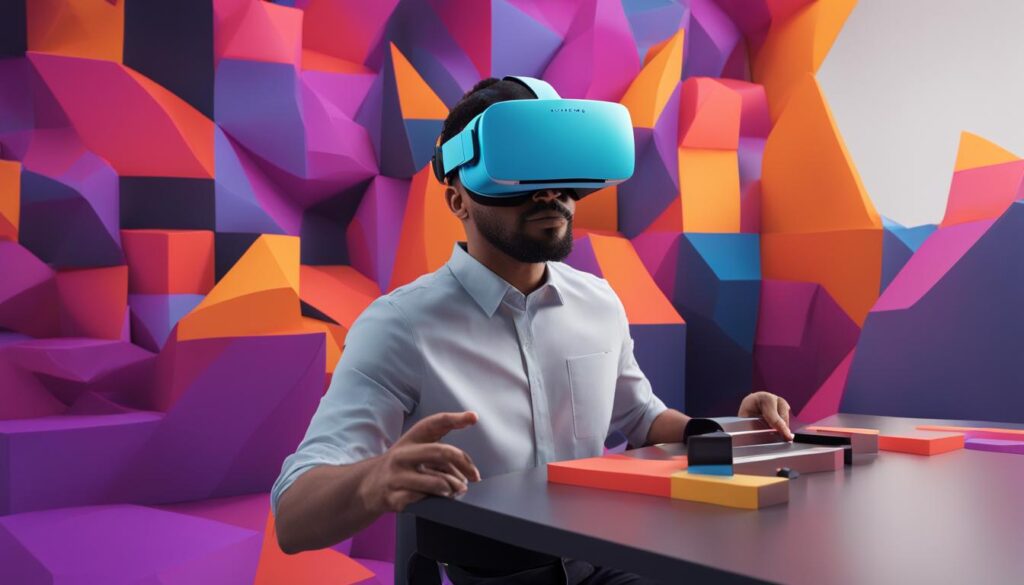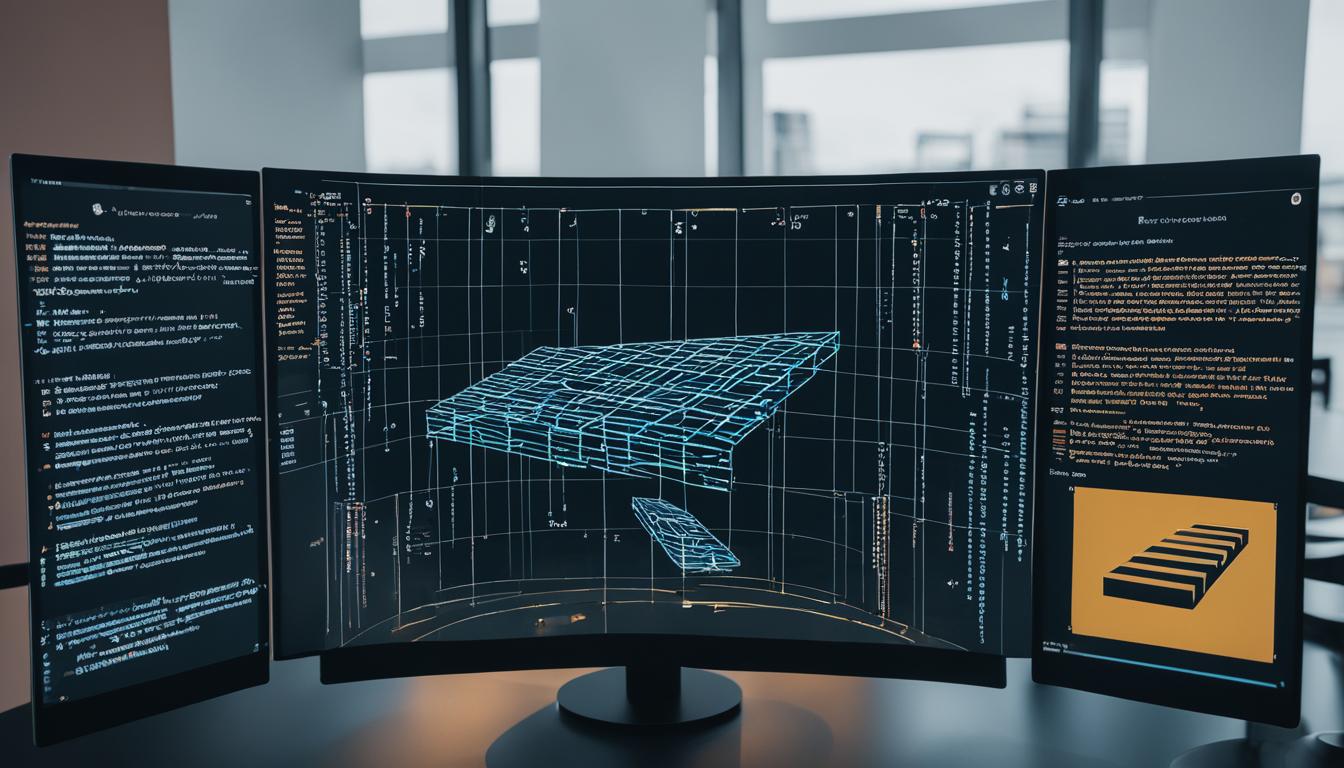Augmented Reality (AR) and Virtual Reality (VR) are transformative technologies that immerse users in interactive 3D environments. JavaScript, a versatile and widely-used programming language, has found its way into AR and VR development, enabling developers to create engaging and interactive experiences.
In this article, we will explore how JavaScript is used in AR and VR development and how it powers interactive 3D experiences. JavaScript plays a significant role in AR and VR development in several ways. It allows developers to create web-based AR and VR applications, provides capabilities for interactivity, 3D graphics, data manipulation, user interfaces, and animation. There are also frameworks and libraries available for AR and VR development using JavaScript, such as A-Frame, Three.js, AR.js, and Babylon.js. JavaScript in AR and VR finds application in various domains, including gaming, education, training, visualization, and marketing. However, there are challenges in AR and VR development with JavaScript, such as performance limitations compared to lower-level languages, compatibility issues, and the complexity of developing AR and VR applications.
Contents
- 1 Web-Based AR and VR Development with JavaScript
- 2 Interactivity in AR and VR with JavaScript
- 3 Data Manipulation in AR and VR with JavaScript
- 4 User Interfaces and Animation in AR and VR with JavaScript
- 5 Conclusion
- 6 FAQ
- 6.1 How does JavaScript apply to augmented reality?
- 6.2 Can JavaScript be used for programming with augmented reality?
- 6.3 Are there JavaScript libraries available for augmented reality development?
- 6.4 How can JavaScript be optimized for augmented reality?
- 6.5 Can JavaScript be used for virtual reality development?
- 6.6 What are the benefits of using JavaScript for web-based AR and VR development?
- 6.7 How can JavaScript enable interactivity in AR and VR environments?
- 6.8 What is the role of JavaScript libraries like Three.js in AR and VR development?
- 6.9 How can JavaScript manipulate data in real-time within AR and VR applications?
- 6.10 Can JavaScript be used to create user interfaces and animations in AR and VR?
- 6.11 What is the future of JavaScript in AR and VR development?
- 7 Source Links
Key Takeaways:
- JavaScript is widely used in AR and VR development, enabling the creation of interactive 3D experiences.
- Web-based AR and VR applications can be developed using JavaScript, eliminating the need for standalone apps.
- JavaScript allows for interactivity, 3D graphics, data manipulation, user interfaces, and animation in AR and VR applications.
- Frameworks and libraries like A-Frame and Three.js provide additional capabilities for AR and VR development with JavaScript.
- Despite its advantages, JavaScript in AR and VR development has challenges such as performance limitations and compatibility issues.
Web-Based AR and VR Development with JavaScript
JavaScript, when combined with cutting-edge technologies like WebXR and A-Frame, empowers developers to create web-based AR and VR applications. This innovative approach allows users to access AR and VR experiences directly through their web browsers, eliminating the need to download standalone apps. By leveraging JavaScript, WebXR, and A-Frame, developers can deliver immersive and interactive AR and VR content through the convenience of a web browser.
- JavaScript enables the creation of web-based AR and VR applications accessible through web browsers
- WebXR and A-Frame provide the necessary frameworks and libraries for seamless web-based AR and VR development
- No additional installations or downloads are required, offering users easy access to AR and VR content
This advancement in web-based AR and VR development with JavaScript offers unparalleled accessibility and flexibility. Users can now experience AR and VR content effortlessly, making the technology more widely available and inclusive. Instead of relying on complex installations and dedicated apps, JavaScript empowers developers to create engaging and immersive AR and VR experiences that can be accessed directly from the browser.
By utilizing WebXR and A-Frame, developers can leverage the full potential of JavaScript to deliver memorable and interactive web experiences. These technologies provide the tools and capabilities necessary to create stunning visuals, dynamic interactions, and seamless integration of AR and VR elements within web applications.
Web-based AR and VR development with JavaScript not only simplifies the user experience but also opens up new possibilities for businesses and developers. By eliminating the need for standalone apps, web-based AR and VR applications can reach a wider audience, making immersive experiences more accessible and engaging.
Interactivity in AR and VR with JavaScript
JavaScript plays a crucial role in creating interactive elements within Augmented Reality (AR) and Virtual Reality (VR) environments. Its event handling capabilities allow developers to incorporate interactivity into AR and VR applications, enabling users to engage with the virtual world in a more immersive way.
With JavaScript, developers can add a range of interactive elements, such as buttons, menus, and interactive objects, that users can interact with within the AR and VR space. These interactive elements enhance user engagement and enhance the overall user experience.
By leveraging JavaScript’s event handling functionality, developers can create custom behaviors for these interactive elements, defining how they respond to user actions such as button clicks or object interactions. This level of interactivity allows for dynamic and personalized experiences in AR and VR applications.
For example, JavaScript can be used to create a menu system in an AR application that enables users to select different options or navigate through different scenes. The menu can be designed using HTML and styled with CSS, while JavaScript provides the necessary functionality to track and respond to user selections.
Similarly, developers can utilize JavaScript to create buttons that trigger specific actions, such as animating objects or changing the environment in real-time. By defining event handlers in JavaScript, developers can tie the button’s functionality to specific actions or behaviors within the AR or VR environment.
Moreover, JavaScript allows for the creation of interactive objects that respond to user interactions. These objects can be programmed to react when touched, moved, or manipulated, offering users a more tactile and immersive experience.
By combining JavaScript’s event handling capabilities with other tools, libraries, and frameworks for AR and VR development, developers can create compelling and interactive experiences that captivate users and bring the virtual world to life.
| Interactive Elements | Examples |
|---|---|
| Buttons | Start/stop animations, change scenes, trigger actions |
| Menus | Navigate through options, select different scenes or content |
| Interactive Objects | Manipulate 3D objects, trigger responses based on user actions |
With JavaScript’s capabilities in event handling and interactivity, AR and VR applications can provide users with a more engaging and immersive experience. Whether it’s through a button that triggers a captivating animation or an interactive object that responds to a user’s touch, JavaScript empowers developers to create interactive AR and VR worlds that users can explore and interact with.

Data Manipulation in AR and VR with JavaScript
JavaScript plays a crucial role in enabling data manipulation in Augmented Reality (AR) and Virtual Reality (VR) applications. With JavaScript, developers have the power to dynamically load and manipulate data, providing real-time updates and interactions in AR and VR experiences.
One of the key benefits of using JavaScript is its ability to fetch data from various sources such as APIs or databases. Developers can retrieve relevant data and manipulate it on the fly, ensuring that the content in AR and VR applications remains up to date. This dynamic data loading capability allows for personalized experiences and real-time updates, creating engaging and immersive AR and VR environments.
The manipulation of data in AR and VR applications with JavaScript opens up countless possibilities. For example, developers can integrate live data feeds from sensors or IoT devices into AR and VR experiences, providing users with real-time information and interactions. This can be particularly useful in training simulations, where users can practice real-world scenarios and receive immediate feedback based on their interactions.
In addition to real-time updates, JavaScript facilitates the manipulation of data within AR and VR applications. Developers can use JavaScript to process and transform the data, enabling complex interactions and visualizations. This allows for the creation of interactive data visualizations, graphs, and charts within AR and VR environments, enhancing the understanding and engagement of users.
Data Manipulation Techniques:
- Dynamic Loading: JavaScript enables the dynamic loading of data, fetching information from APIs or databases at runtime to ensure real-time updates in AR and VR applications.
- Manipulation and Transformation: JavaScript provides powerful data manipulation capabilities, allowing developers to process, transform, and filter data to create meaningful and interactive experiences in AR and VR.
- Interactive Data Visualizations: With JavaScript, developers can create dynamic and interactive data visualizations within AR and VR environments, enhancing the understanding and analysis of complex data sets.
By leveraging JavaScript for data manipulation in AR and VR, developers can create immersive experiences that respond to real-time data, engage users with interactive visualizations, and provide personalized content.
| Advantages of Data Manipulation in AR and VR with JavaScript | Challenges of Data Manipulation in AR and VR with JavaScript |
|---|---|
|
|

“JavaScript’s data manipulation capabilities in AR and VR unlock new possibilities for real-time updates, interactive visualizations, and personalized experiences. As developers continue to explore the potential of AR and VR applications, JavaScript proves to be a powerful tool for creating dynamic and immersive environments.”
User Interfaces and Animation in AR and VR with JavaScript
JavaScript is a versatile programming language that enables developers to create immersive user interfaces (UI) and Heads-Up Displays (HUDs) in Augmented Reality (AR) and Virtual Reality (VR). With JavaScript, you can design interactive UI elements, buttons, menus, and HUDs that enhance the user experience in AR and VR applications. These interfaces provide users with the ability to interact with the application and access information seamlessly.
Furthermore, JavaScript offers a range of animation libraries and frameworks that empower developers to create dynamic and immersive animations in AR and VR environments. These animations elevate the overall user experience, capturing attention and enhancing engagement. Through JavaScript animation libraries and frameworks, developers can add movement, transitions, and visual effects to their AR and VR applications, making them more visually appealing and interactive.
By leveraging JavaScript’s capabilities for creating UI and HUDs, as well as its animation libraries and frameworks, developers can craft visually striking and interactive AR and VR experiences. Whether it’s designing a user-friendly menu system, implementing intuitive UI elements, or animating objects within the virtual environment, JavaScript provides the tools necessary to create captivating and user-centric AR and VR applications.
Take a look at the example below showcasing an interactive AR interface designed with JavaScript:
“JavaScript’s versatility and powerful animation libraries allowed us to create an immersive AR experience for users. The intuitive UI elements and smooth animations contribute to a seamless and engaging user interface, enabling users to interact effortlessly with the virtual objects. JavaScript’s ability to handle user interactions and create dynamic animations significantly enhanced the visual appeal and interactivity of our AR application.”
– Mark Johnson, Lead AR Developer at XYZ Technologies
JavaScript Animation Libraries and Frameworks:
- Three.js: A popular JavaScript library for rendering 3D graphics in AR and VR applications.
- A-Frame: A web framework for building virtual reality experiences using HTML and JavaScript.
- AR.js: A lightweight augmented reality library for creating AR experiences on the web.
- Babylon.js: A powerful framework for 3D game development and VR experiences.
These animation libraries and frameworks provide developers with a wide range of tools and capabilities to bring their AR and VR applications to life. With JavaScript’s UI design features and animation libraries, the possibilities for creating immersive and interactive AR and VR experiences are virtually limitless.

The image above demonstrates the integration of JavaScript in creating user interfaces and implementing animations in AR and VR applications.
Conclusion
JavaScript’s integration into AR and VR development has revolutionized the creation of immersive and interactive 3D experiences. With the emergence of web-based AR and VR applications driven by JavaScript and related libraries, accessibility and reach have increased significantly. JavaScript’s versatility and the availability of frameworks and libraries for AR and VR development have made it an essential tool for building engaging and interactive experiences in these emerging fields.
As AR and VR technologies continue to advance, the future of JavaScript in shaping immersive 3D environments looks promising. JavaScript has already proved its worth in delivering stunning visuals, enabling interactivity, manipulating data, and creating user interfaces in AR and VR applications. Its continued evolution and integration with cutting-edge technologies will unlock even more exciting opportunities for developers to push the boundaries of creativity and innovation in AR and VR development.
With JavaScript at the forefront, the future of AR and VR is destined to be richly immersive, allowing users to step into dynamic virtual worlds and experience interactive 3D environments like never before. As the demand for AR and VR applications grows across various domains, JavaScript’s role will only become more crucial in delivering captivating and meaningful experiences to users around the globe.
FAQ
How does JavaScript apply to augmented reality?
JavaScript plays a significant role in augmented reality (AR) development by enabling developers to create web-based AR applications, providing capabilities for interactivity, 3D graphics, data manipulation, user interfaces, and animation.
Can JavaScript be used for programming with augmented reality?
Yes, JavaScript can be used for programming with augmented reality. It allows developers to create interactive AR experiences, manipulate 3D graphics, load and manipulate data, create user interfaces, and incorporate animations.
Are there JavaScript libraries available for augmented reality development?
Yes, there are several JavaScript libraries available for augmented reality development, including A-Frame, Three.js, AR.js, and Babylon.js. These libraries provide APIs and tools for creating and manipulating 3D graphics, scenes, and interactive elements in AR applications.
How can JavaScript be optimized for augmented reality?
JavaScript can be optimized for augmented reality by minimizing unnecessary operations, optimizing code execution, reducing memory usage, and utilizing performance-enhancing techniques like code splitting and lazy loading. Additionally, leveraging JavaScript frameworks and libraries specifically designed for AR can help optimize performance and enhance the overall AR experience.
Can JavaScript be used for virtual reality development?
Yes, JavaScript can be used for virtual reality (VR) development. It offers similar capabilities as in AR development, including creating interactive VR experiences, manipulating 3D graphics, loading and manipulating data, creating user interfaces, and incorporating animations.
What are the benefits of using JavaScript for web-based AR and VR development?
JavaScript, combined with technologies like WebXR and A-Frame, allows developers to create web-based AR and VR applications that can be accessed directly through browsers, eliminating the need for standalone apps. This provides accessibility and flexibility for users to easily access and experience AR and VR content without additional installations or downloads.
How can JavaScript enable interactivity in AR and VR environments?
JavaScript’s capabilities for event handling and interaction make it ideal for creating interactive elements within AR and VR environments. Developers can use JavaScript to add buttons, menus, and interactive objects that users can interact with, enhancing user engagement and creating more immersive experiences.
What is the role of JavaScript libraries like Three.js in AR and VR development?
JavaScript libraries like Three.js provide a JavaScript API for creating and manipulating 3D graphics and scenes. Developers can use Three.js to render complex 3D environments, create and manipulate 3D objects, apply textures and materials, and create dynamic and interactive 3D scenes, resulting in visually stunning and engaging experiences in AR and VR.
How can JavaScript manipulate data in real-time within AR and VR applications?
JavaScript can be used to dynamically load and manipulate data within AR and VR applications. Developers can fetch data from APIs, databases, or other sources and use JavaScript to manipulate it, enabling real-time updates and interactions. This allows for real-time updates of content, interaction with real-time data, and personalized experiences in AR and VR.
Can JavaScript be used to create user interfaces and animations in AR and VR?
Yes, JavaScript can be used to create user interfaces (UI) and Heads-Up Displays (HUDs) in AR and VR, allowing users to interact with the application and access information. JavaScript’s animation libraries and frameworks also enable the creation of dynamic and immersive animations in AR and VR, enhancing the overall user experience.
What is the future of JavaScript in AR and VR development?
JavaScript’s integration into augmented reality and virtual reality development has opened up new possibilities for creating immersive and interactive 3D experiences. As AR and VR technologies continue to advance, JavaScript’s role in shaping these environments is set to expand, offering exciting opportunities for developers to create engaging applications in these emerging fields.




